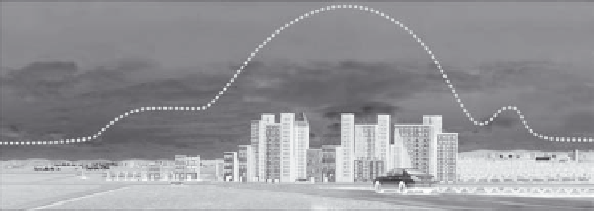Environmental Engineering Reference
In-Depth Information
°C
33
29
Rural
Suburban
Urban
Suburban
Rural
FIGURE 12.11
Temperature profile by land use. (From http://eospso.gsfc.nasa.gov/eos_homepage/for_scientists/data_
products/OurChangingPlanet/PDF/Page_299_new.pdf)
the replacement of vegetation with structures and pavement, along with some input from
traffic (Yalcin and Yeteman 2009). Ambient air temperatures rise and create the profile
across the different types of land uses as shown in Figure 12.11.
One well-documented effect of the UHI is an increase in the magnitude of thunder-
storms over major urban areas (Chagnon 1978). These more intense precipitation events
exacerbate the “first flush” effect—the rapid removal of the most recently deposited con-
taminants from road surfaces (Deletic 1998). Air quality also suffers. The higher levels of
particulate matter present in urban areas means contaminants will be airborne longer
(Chapter 10).
Additional research has revealed other significant impacts, including increased ground-
water temperature (Yalcin and Yeteman 2009) and increased temperatures in surface streams
as a result of the flow of stormwater over warm urban pavement (Leblanc et al. 1997).
The extent of the UHI is impressive. The lighter areas in Figure 12.12 show the elevated
air temperatures detected in the heavily urbanized sections of New York City.
Consider this scenario: it is a hot summer day in an industrial city. Within this city
are hundreds, perhaps thousands of contaminated brownfield sites. Late in the day, an
intense afternoon thunderstorm occurs and delivers 20 min of hard downpours. The
drop sizes are large, and they dislodge significant amounts of soil particles onto which
are adsorbed heavy metals from the brownfield sites. Another cruel injustice occurs: the
intense thunderstorms affect the area of the city with the highest percentage of impervi-
ous surface, and the volume of runoff generated is massive. Tonnes of contaminated soil
particles are entrained by the stormwater and delivered into several tributaries within the
urbanized watershed.
Unfortunately, this is not fiction. At uncapped contaminated sites where there is
exposed soil, stormwater acts as a catalyst for spreading contamination (Murray et al.
2004). Eventually, some of the contaminated soil particles may percolate into groundwater,
especially if acidic precipitation mobilizes them.
12.5 Summary and Conclusion
By examining some of the major environmental impacts specific to urbanized areas and
their watersheds, we obtain a broader scientific foundation required for the planning efforts


Search WWH ::

Custom Search